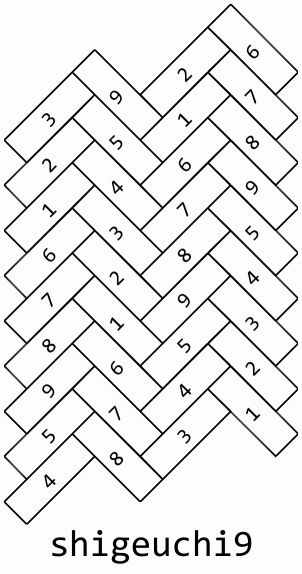9-strand Shigeuchi (繁打九つ組)
The most common sageo (mounting cord) for a katana is a 9-strand braid normally done on the takadai, but instructions for making it on a marudai are here (my own instructions on how to make it on a foam disk are here, in abbreviated form). After a little practice (and the acquisition of a set of 240-gram tama), I made a quite nice one for my primary iaito, using DMC embroidery floss (6x 4-meter strands) to get just the right color combination. It’s extremely quick and easy, especially if you follow Tada-sensei’s pictures and lift two tama at once.
Commercial Shigeuchi sageo are only found in two styles, solid and 2-strand zig-zag (221111111). The reason for this is that most of the other interlacements kind of suck. Shigeuchi is an oblique 2/2 twill pattern, and the progression of strands across the braid is much more regular than most kumihimo braids. Here’s the Carey diagram for the front side (the back is just a 180° rotation):

As you can see, every strand follows the same ordering in every column, severely limiting the possibilities. In fact, the standard “clockwise from the top” numbering system obscures the regularity a bit; if you numbered the five strands on the right 1-5 from the top, and the four on the left 6-9 from the top, the numbers in the above diagram would all be in order, which quickly became obvious in my 9-color test braid.
Viable three-color patterns are even harder to find, and the only three I’ve found that are worth mentioning are 111113322 (double zig-zag), 113323332 (crossing double-zig-zag) and 111223332 (sort-of triple-zig-zag). I’m sure there are others, but my script didn’t do a good job of reducing the search space, leaving me with 674 GIFs to pick through.



[Update: three more 3-color patterns that have potential]



Here are the 29 two-color interlacements. It took a bit of work to get my script to correctly eliminate all of the duplicates, but I think I managed it this time without accidentally eliminating real patterns.





























Next up: 17-strand Shigeuchi, which produces a very wide, soft, flat braid. The setup and braiding are very simple, and I prototyped it on the foam disk just to make sure I got it right. Going clockwise from the top, lay out your strands in groups of: 1, 2, 2, 2, 2, 1, 2, 2, 2, 1. To braid, lift 2 and 3 (left hand) and bring 1 under to below 5; lift 6 and 7 (right hand) and bring 1 under and across to below 10; lift 15 and 16 (right hand) and bring 17 under to below 13; lift 12 and 11 (left hand) and bring 17 under and across to below 9; reset. Try to keep the groups dispersed around the mirror, to keep the tension even.
If you have enough tamas and room on your marudai, you could add 8 more and bring it up to 25. Still not a lot of patterns, but it should be a very wide woven band. If you knocked together a Texas-sized marudai and bobbins, you could make a quite impressive scarf out of chunky yarn. (I’m thinking about it…)
[yes, there are scripts; pretty rough right now, but the pattern-drawing script reads the braid info from a config file, allowing me to color any Carey diagram composed only of rectangles; I need to add some more shapes to match her more complex diagrams. I’ll release them eventually.]